Internet's Impact on Bangladeshi Consumers in London During Pandemic
VerifiedAdded on 2021/07/20
|50
|16521
|109
Report
AI Summary
This report investigates the impact of the internet on Bangladeshi consumers residing in London during the COVID-19 pandemic. The research explores how the internet facilitated online shopping, communication, and access to information during lockdowns and social distancing measures. The study examines the influence of various factors, including ease of reach, customized services, and delivery ease, on consumer behavior. Employing a mixed-methods approach, the research includes a literature review, quantitative analysis based on survey data from 66 respondents, and a discussion section that connects the findings with existing literature. The results reveal that the internet significantly impacted the consumers, influencing their shopping habits. The report concludes with recommendations for businesses to leverage online communication channels, including augmented reality and influencer marketing, to enhance customer engagement and improve the online shopping experience for the target demographic.

Title: Impact of the Internet on Bangladeshi consumers in London in
the pandemic time of Covid-19.
1
the pandemic time of Covid-19.
1
Paraphrase This Document
Need a fresh take? Get an instant paraphrase of this document with our AI Paraphraser

Contents
Executive summary:........................................................................................................................4
Chapter 01: Introduction 800...........................................................................................................5
1.1 Background 250................................................................................................................5
1.2 Rationale...........................................................................................................................5
1.3 Aims & Objectives............................................................................................................6
1.4 Research Questions...........................................................................................................7
1.5 Research Structure............................................................................................................7
Chapter 02: Literature Review.........................................................................................................8
2.1 Introduction............................................................................................................................8
2.2 Concept of Internet (150 words)............................................................................................8
2.3 Internet and its Implication (1500 words).............................................................................8
2.3.1 Information accessibility..............................................................................................12
2.3.2 Easiness of Reach.........................................................................................................13
2.3.3 Customized Service......................................................................................................14
2.3.4 Delivery Ease................................................................................................................15
2.4 Conceptual Framework........................................................................................................16
3 Methodology 2000.................................................................................................................17
3.1 Introduction:........................................................................................................................17
3.2 Philosophy.......................................................................................................................17
3.3 Approach.........................................................................................................................18
3.4 Strategy...........................................................................................................................19
3.5 Research method:.................................................................................................................20
3.6 Data collection method...................................................................................................20
3.7 Sampling.........................................................................................................................21
2
Executive summary:........................................................................................................................4
Chapter 01: Introduction 800...........................................................................................................5
1.1 Background 250................................................................................................................5
1.2 Rationale...........................................................................................................................5
1.3 Aims & Objectives............................................................................................................6
1.4 Research Questions...........................................................................................................7
1.5 Research Structure............................................................................................................7
Chapter 02: Literature Review.........................................................................................................8
2.1 Introduction............................................................................................................................8
2.2 Concept of Internet (150 words)............................................................................................8
2.3 Internet and its Implication (1500 words).............................................................................8
2.3.1 Information accessibility..............................................................................................12
2.3.2 Easiness of Reach.........................................................................................................13
2.3.3 Customized Service......................................................................................................14
2.3.4 Delivery Ease................................................................................................................15
2.4 Conceptual Framework........................................................................................................16
3 Methodology 2000.................................................................................................................17
3.1 Introduction:........................................................................................................................17
3.2 Philosophy.......................................................................................................................17
3.3 Approach.........................................................................................................................18
3.4 Strategy...........................................................................................................................19
3.5 Research method:.................................................................................................................20
3.6 Data collection method...................................................................................................20
3.7 Sampling.........................................................................................................................21
2
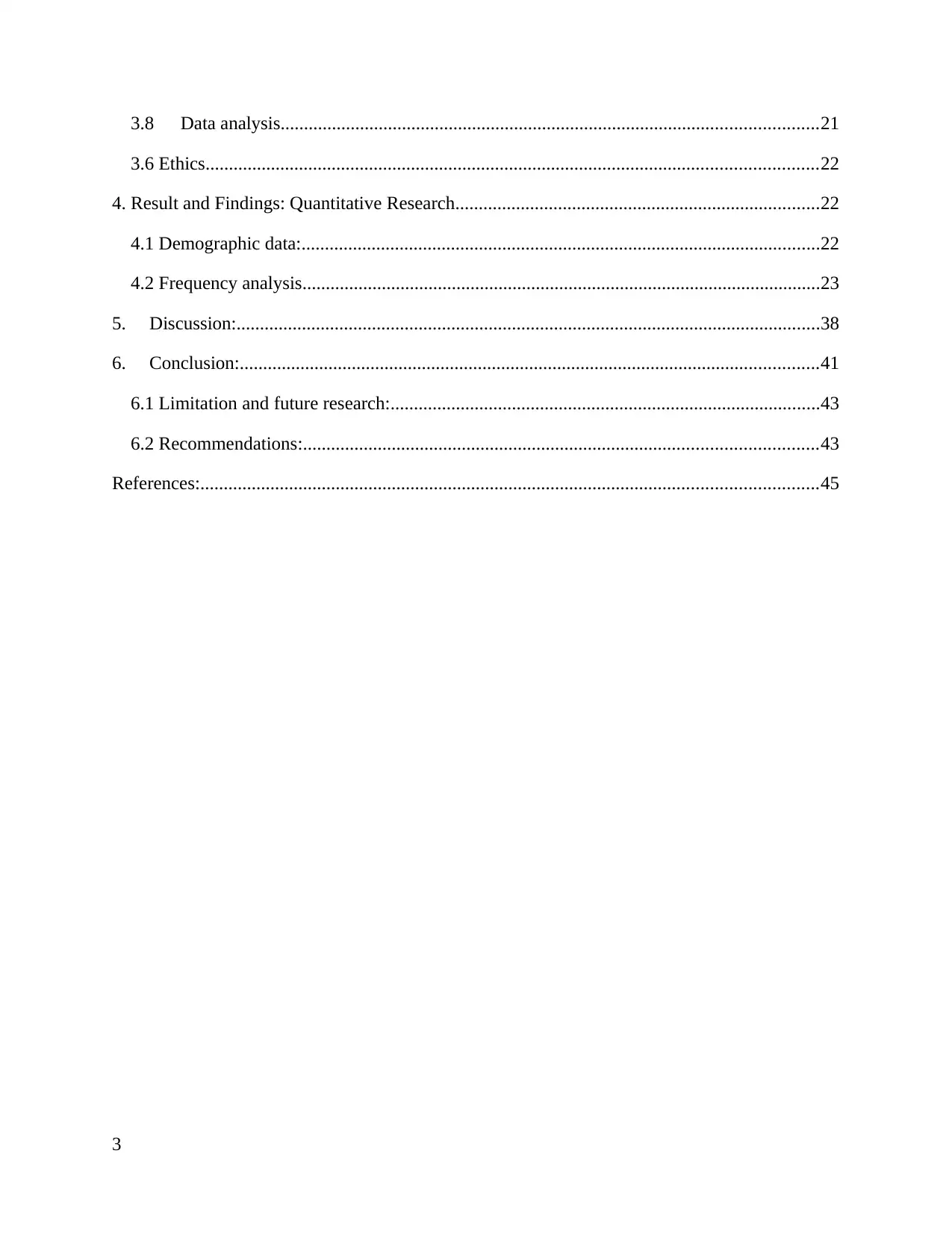
3.8 Data analysis...................................................................................................................21
3.6 Ethics...................................................................................................................................22
4. Result and Findings: Quantitative Research..............................................................................22
4.1 Demographic data:...............................................................................................................22
4.2 Frequency analysis...............................................................................................................23
5. Discussion:.............................................................................................................................38
6. Conclusion:............................................................................................................................41
6.1 Limitation and future research:............................................................................................43
6.2 Recommendations:..............................................................................................................43
References:....................................................................................................................................45
3
3.6 Ethics...................................................................................................................................22
4. Result and Findings: Quantitative Research..............................................................................22
4.1 Demographic data:...............................................................................................................22
4.2 Frequency analysis...............................................................................................................23
5. Discussion:.............................................................................................................................38
6. Conclusion:............................................................................................................................41
6.1 Limitation and future research:............................................................................................43
6.2 Recommendations:..............................................................................................................43
References:....................................................................................................................................45
3
⊘ This is a preview!⊘
Do you want full access?
Subscribe today to unlock all pages.

Trusted by 1+ million students worldwide
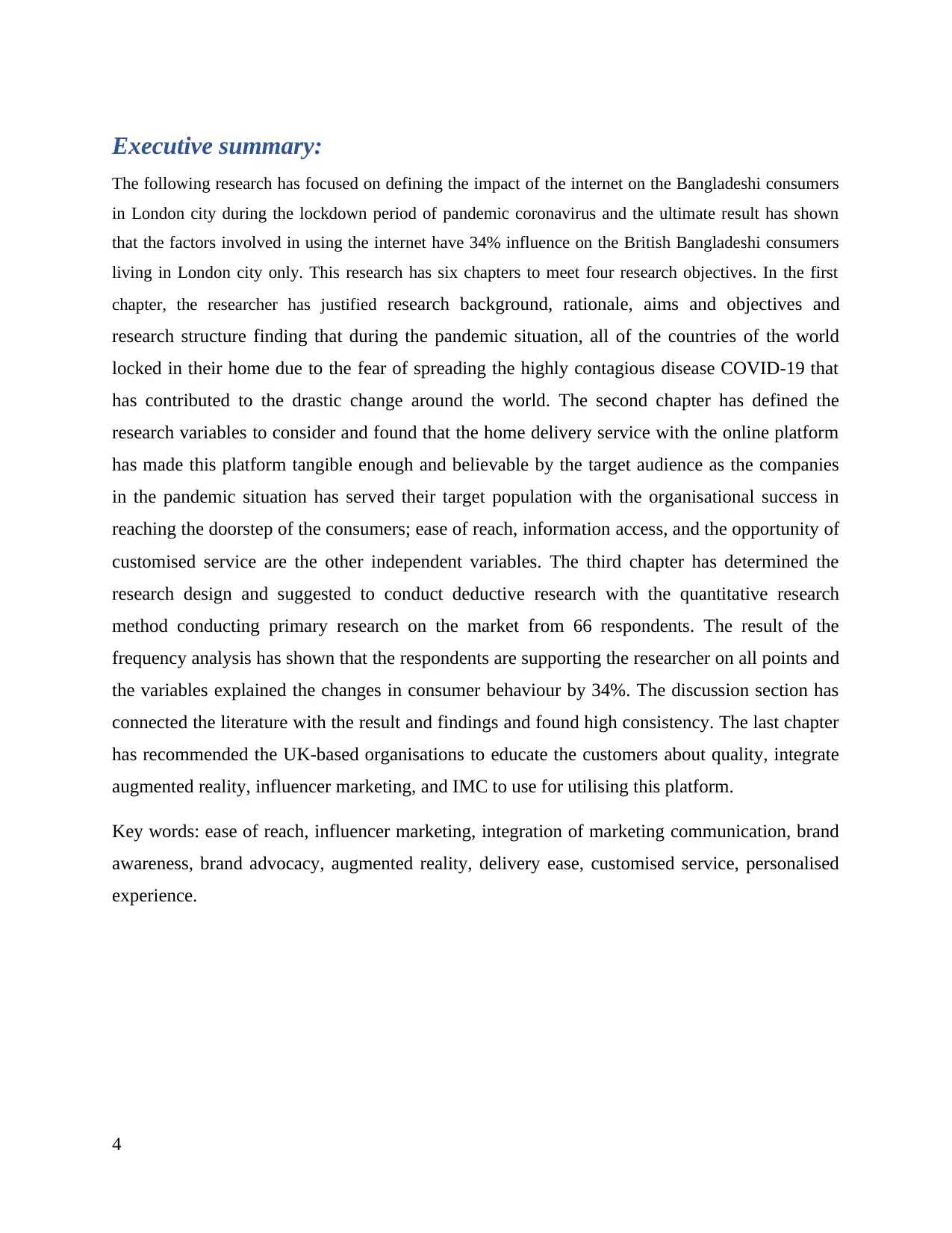
Executive summary:
The following research has focused on defining the impact of the internet on the Bangladeshi consumers
in London city during the lockdown period of pandemic coronavirus and the ultimate result has shown
that the factors involved in using the internet have 34% influence on the British Bangladeshi consumers
living in London city only. This research has six chapters to meet four research objectives. In the first
chapter, the researcher has justified research background, rationale, aims and objectives and
research structure finding that during the pandemic situation, all of the countries of the world
locked in their home due to the fear of spreading the highly contagious disease COVID-19 that
has contributed to the drastic change around the world. The second chapter has defined the
research variables to consider and found that the home delivery service with the online platform
has made this platform tangible enough and believable by the target audience as the companies
in the pandemic situation has served their target population with the organisational success in
reaching the doorstep of the consumers; ease of reach, information access, and the opportunity of
customised service are the other independent variables. The third chapter has determined the
research design and suggested to conduct deductive research with the quantitative research
method conducting primary research on the market from 66 respondents. The result of the
frequency analysis has shown that the respondents are supporting the researcher on all points and
the variables explained the changes in consumer behaviour by 34%. The discussion section has
connected the literature with the result and findings and found high consistency. The last chapter
has recommended the UK-based organisations to educate the customers about quality, integrate
augmented reality, influencer marketing, and IMC to use for utilising this platform.
Key words: ease of reach, influencer marketing, integration of marketing communication, brand
awareness, brand advocacy, augmented reality, delivery ease, customised service, personalised
experience.
4
The following research has focused on defining the impact of the internet on the Bangladeshi consumers
in London city during the lockdown period of pandemic coronavirus and the ultimate result has shown
that the factors involved in using the internet have 34% influence on the British Bangladeshi consumers
living in London city only. This research has six chapters to meet four research objectives. In the first
chapter, the researcher has justified research background, rationale, aims and objectives and
research structure finding that during the pandemic situation, all of the countries of the world
locked in their home due to the fear of spreading the highly contagious disease COVID-19 that
has contributed to the drastic change around the world. The second chapter has defined the
research variables to consider and found that the home delivery service with the online platform
has made this platform tangible enough and believable by the target audience as the companies
in the pandemic situation has served their target population with the organisational success in
reaching the doorstep of the consumers; ease of reach, information access, and the opportunity of
customised service are the other independent variables. The third chapter has determined the
research design and suggested to conduct deductive research with the quantitative research
method conducting primary research on the market from 66 respondents. The result of the
frequency analysis has shown that the respondents are supporting the researcher on all points and
the variables explained the changes in consumer behaviour by 34%. The discussion section has
connected the literature with the result and findings and found high consistency. The last chapter
has recommended the UK-based organisations to educate the customers about quality, integrate
augmented reality, influencer marketing, and IMC to use for utilising this platform.
Key words: ease of reach, influencer marketing, integration of marketing communication, brand
awareness, brand advocacy, augmented reality, delivery ease, customised service, personalised
experience.
4
Paraphrase This Document
Need a fresh take? Get an instant paraphrase of this document with our AI Paraphraser
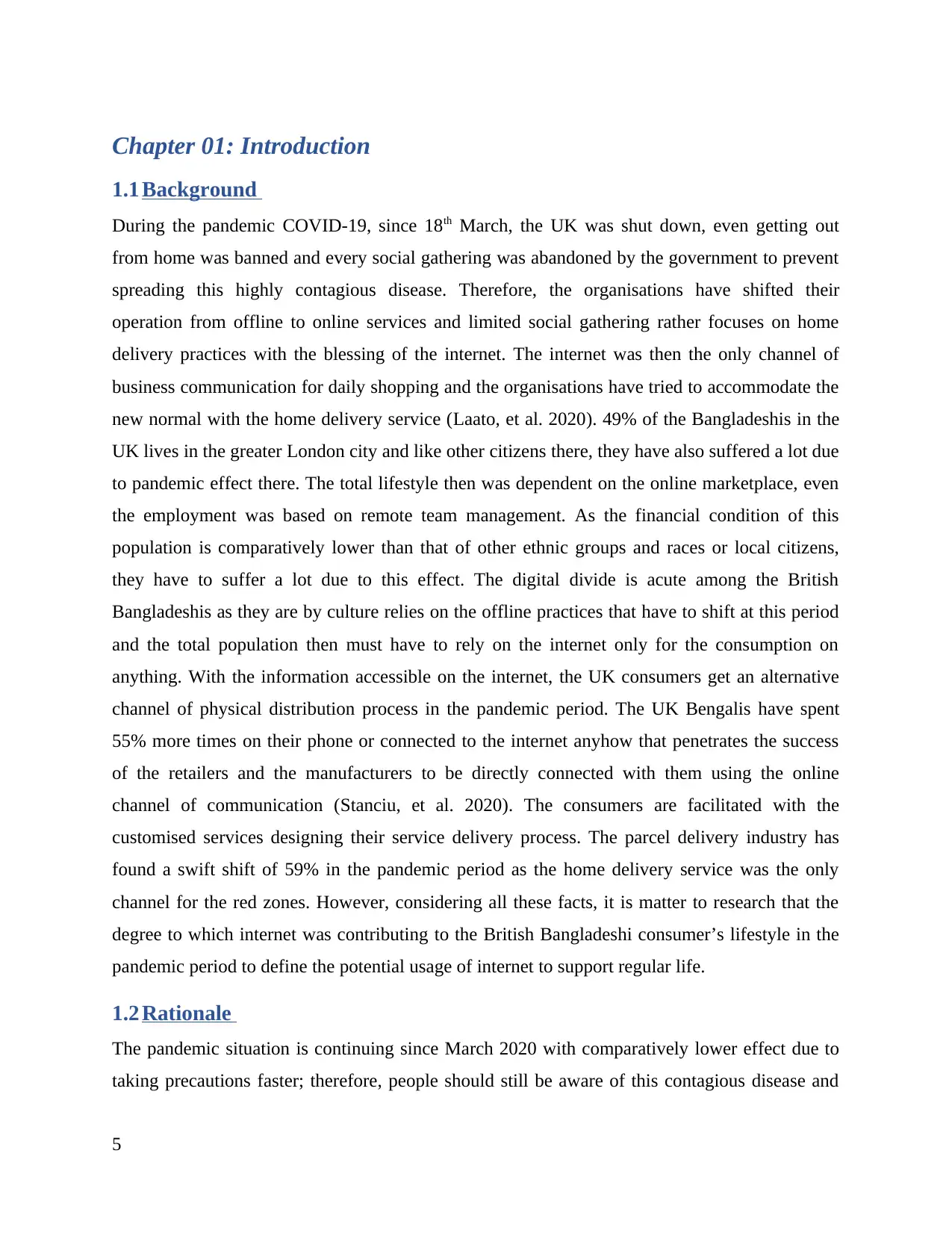
Chapter 01: Introduction
1.1 Background
During the pandemic COVID-19, since 18th March, the UK was shut down, even getting out
from home was banned and every social gathering was abandoned by the government to prevent
spreading this highly contagious disease. Therefore, the organisations have shifted their
operation from offline to online services and limited social gathering rather focuses on home
delivery practices with the blessing of the internet. The internet was then the only channel of
business communication for daily shopping and the organisations have tried to accommodate the
new normal with the home delivery service (Laato, et al. 2020). 49% of the Bangladeshis in the
UK lives in the greater London city and like other citizens there, they have also suffered a lot due
to pandemic effect there. The total lifestyle then was dependent on the online marketplace, even
the employment was based on remote team management. As the financial condition of this
population is comparatively lower than that of other ethnic groups and races or local citizens,
they have to suffer a lot due to this effect. The digital divide is acute among the British
Bangladeshis as they are by culture relies on the offline practices that have to shift at this period
and the total population then must have to rely on the internet only for the consumption on
anything. With the information accessible on the internet, the UK consumers get an alternative
channel of physical distribution process in the pandemic period. The UK Bengalis have spent
55% more times on their phone or connected to the internet anyhow that penetrates the success
of the retailers and the manufacturers to be directly connected with them using the online
channel of communication (Stanciu, et al. 2020). The consumers are facilitated with the
customised services designing their service delivery process. The parcel delivery industry has
found a swift shift of 59% in the pandemic period as the home delivery service was the only
channel for the red zones. However, considering all these facts, it is matter to research that the
degree to which internet was contributing to the British Bangladeshi consumer’s lifestyle in the
pandemic period to define the potential usage of internet to support regular life.
1.2 Rationale
The pandemic situation is continuing since March 2020 with comparatively lower effect due to
taking precautions faster; therefore, people should still be aware of this contagious disease and
5
1.1 Background
During the pandemic COVID-19, since 18th March, the UK was shut down, even getting out
from home was banned and every social gathering was abandoned by the government to prevent
spreading this highly contagious disease. Therefore, the organisations have shifted their
operation from offline to online services and limited social gathering rather focuses on home
delivery practices with the blessing of the internet. The internet was then the only channel of
business communication for daily shopping and the organisations have tried to accommodate the
new normal with the home delivery service (Laato, et al. 2020). 49% of the Bangladeshis in the
UK lives in the greater London city and like other citizens there, they have also suffered a lot due
to pandemic effect there. The total lifestyle then was dependent on the online marketplace, even
the employment was based on remote team management. As the financial condition of this
population is comparatively lower than that of other ethnic groups and races or local citizens,
they have to suffer a lot due to this effect. The digital divide is acute among the British
Bangladeshis as they are by culture relies on the offline practices that have to shift at this period
and the total population then must have to rely on the internet only for the consumption on
anything. With the information accessible on the internet, the UK consumers get an alternative
channel of physical distribution process in the pandemic period. The UK Bengalis have spent
55% more times on their phone or connected to the internet anyhow that penetrates the success
of the retailers and the manufacturers to be directly connected with them using the online
channel of communication (Stanciu, et al. 2020). The consumers are facilitated with the
customised services designing their service delivery process. The parcel delivery industry has
found a swift shift of 59% in the pandemic period as the home delivery service was the only
channel for the red zones. However, considering all these facts, it is matter to research that the
degree to which internet was contributing to the British Bangladeshi consumer’s lifestyle in the
pandemic period to define the potential usage of internet to support regular life.
1.2 Rationale
The pandemic situation is continuing since March 2020 with comparatively lower effect due to
taking precautions faster; therefore, people should still be aware of this contagious disease and
5
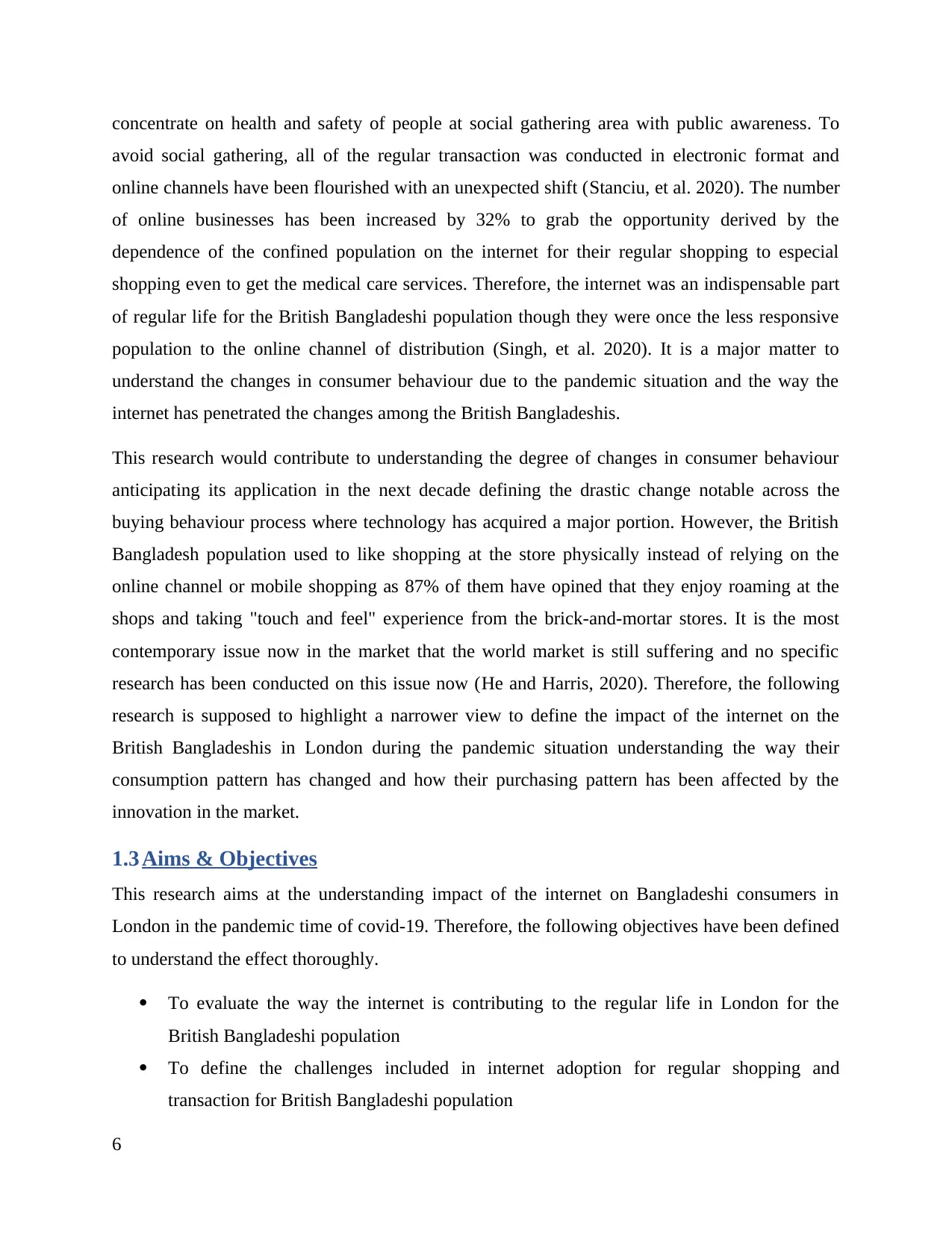
concentrate on health and safety of people at social gathering area with public awareness. To
avoid social gathering, all of the regular transaction was conducted in electronic format and
online channels have been flourished with an unexpected shift (Stanciu, et al. 2020). The number
of online businesses has been increased by 32% to grab the opportunity derived by the
dependence of the confined population on the internet for their regular shopping to especial
shopping even to get the medical care services. Therefore, the internet was an indispensable part
of regular life for the British Bangladeshi population though they were once the less responsive
population to the online channel of distribution (Singh, et al. 2020). It is a major matter to
understand the changes in consumer behaviour due to the pandemic situation and the way the
internet has penetrated the changes among the British Bangladeshis.
This research would contribute to understanding the degree of changes in consumer behaviour
anticipating its application in the next decade defining the drastic change notable across the
buying behaviour process where technology has acquired a major portion. However, the British
Bangladesh population used to like shopping at the store physically instead of relying on the
online channel or mobile shopping as 87% of them have opined that they enjoy roaming at the
shops and taking "touch and feel" experience from the brick-and-mortar stores. It is the most
contemporary issue now in the market that the world market is still suffering and no specific
research has been conducted on this issue now (He and Harris, 2020). Therefore, the following
research is supposed to highlight a narrower view to define the impact of the internet on the
British Bangladeshis in London during the pandemic situation understanding the way their
consumption pattern has changed and how their purchasing pattern has been affected by the
innovation in the market.
1.3 Aims & Objectives
This research aims at the understanding impact of the internet on Bangladeshi consumers in
London in the pandemic time of covid-19. Therefore, the following objectives have been defined
to understand the effect thoroughly.
To evaluate the way the internet is contributing to the regular life in London for the
British Bangladeshi population
To define the challenges included in internet adoption for regular shopping and
transaction for British Bangladeshi population
6
avoid social gathering, all of the regular transaction was conducted in electronic format and
online channels have been flourished with an unexpected shift (Stanciu, et al. 2020). The number
of online businesses has been increased by 32% to grab the opportunity derived by the
dependence of the confined population on the internet for their regular shopping to especial
shopping even to get the medical care services. Therefore, the internet was an indispensable part
of regular life for the British Bangladeshi population though they were once the less responsive
population to the online channel of distribution (Singh, et al. 2020). It is a major matter to
understand the changes in consumer behaviour due to the pandemic situation and the way the
internet has penetrated the changes among the British Bangladeshis.
This research would contribute to understanding the degree of changes in consumer behaviour
anticipating its application in the next decade defining the drastic change notable across the
buying behaviour process where technology has acquired a major portion. However, the British
Bangladesh population used to like shopping at the store physically instead of relying on the
online channel or mobile shopping as 87% of them have opined that they enjoy roaming at the
shops and taking "touch and feel" experience from the brick-and-mortar stores. It is the most
contemporary issue now in the market that the world market is still suffering and no specific
research has been conducted on this issue now (He and Harris, 2020). Therefore, the following
research is supposed to highlight a narrower view to define the impact of the internet on the
British Bangladeshis in London during the pandemic situation understanding the way their
consumption pattern has changed and how their purchasing pattern has been affected by the
innovation in the market.
1.3 Aims & Objectives
This research aims at the understanding impact of the internet on Bangladeshi consumers in
London in the pandemic time of covid-19. Therefore, the following objectives have been defined
to understand the effect thoroughly.
To evaluate the way the internet is contributing to the regular life in London for the
British Bangladeshi population
To define the challenges included in internet adoption for regular shopping and
transaction for British Bangladeshi population
6
⊘ This is a preview!⊘
Do you want full access?
Subscribe today to unlock all pages.

Trusted by 1+ million students worldwide

To examine how the factors included in the adapting online channel of communication in
the pandemic situation for British Bangladeshi consumers in London
To recommend the way online communication channels can boost customer engagement
with the further pleasing shopping experience and reliability
1.4 Research Questions
General question: What is the impact of the internet on Bangladeshi consumers in London in
the pandemic time of Covid-19?
How does the internet contribute to regular life in the pandemic situation in the UK?
What are the challenges included in internet adoption for regular shopping and
transaction for British Bangladeshi population?
How the factors included in the adapting online channel of communication in the
pandemic situation affect British Bangladeshi consumers in London?
How does online communication channels can boost customer engagement with further
pleasing shopping experience and reliability?
1.5 Research Structure
Chapter Name Description
1 Introduction The identification of the research background and why to
conduct this research determining the aim, objectives, and
research question
2 Literature Review Constructing the thorough theoretical analysis of the research
to define the variables to consider for further research with
the findings of the previous researchers
3 Methodology The research tools and techniques determined to conduct the
research and successfully meet the research objective
4 Result Analysing the collected data and demonstrating them to meet
the research objective
5 Discussion The integration of research findings from the literature
review and mixed research conducted to understand whether
all the objectives are met
7
the pandemic situation for British Bangladeshi consumers in London
To recommend the way online communication channels can boost customer engagement
with the further pleasing shopping experience and reliability
1.4 Research Questions
General question: What is the impact of the internet on Bangladeshi consumers in London in
the pandemic time of Covid-19?
How does the internet contribute to regular life in the pandemic situation in the UK?
What are the challenges included in internet adoption for regular shopping and
transaction for British Bangladeshi population?
How the factors included in the adapting online channel of communication in the
pandemic situation affect British Bangladeshi consumers in London?
How does online communication channels can boost customer engagement with further
pleasing shopping experience and reliability?
1.5 Research Structure
Chapter Name Description
1 Introduction The identification of the research background and why to
conduct this research determining the aim, objectives, and
research question
2 Literature Review Constructing the thorough theoretical analysis of the research
to define the variables to consider for further research with
the findings of the previous researchers
3 Methodology The research tools and techniques determined to conduct the
research and successfully meet the research objective
4 Result Analysing the collected data and demonstrating them to meet
the research objective
5 Discussion The integration of research findings from the literature
review and mixed research conducted to understand whether
all the objectives are met
7
Paraphrase This Document
Need a fresh take? Get an instant paraphrase of this document with our AI Paraphraser
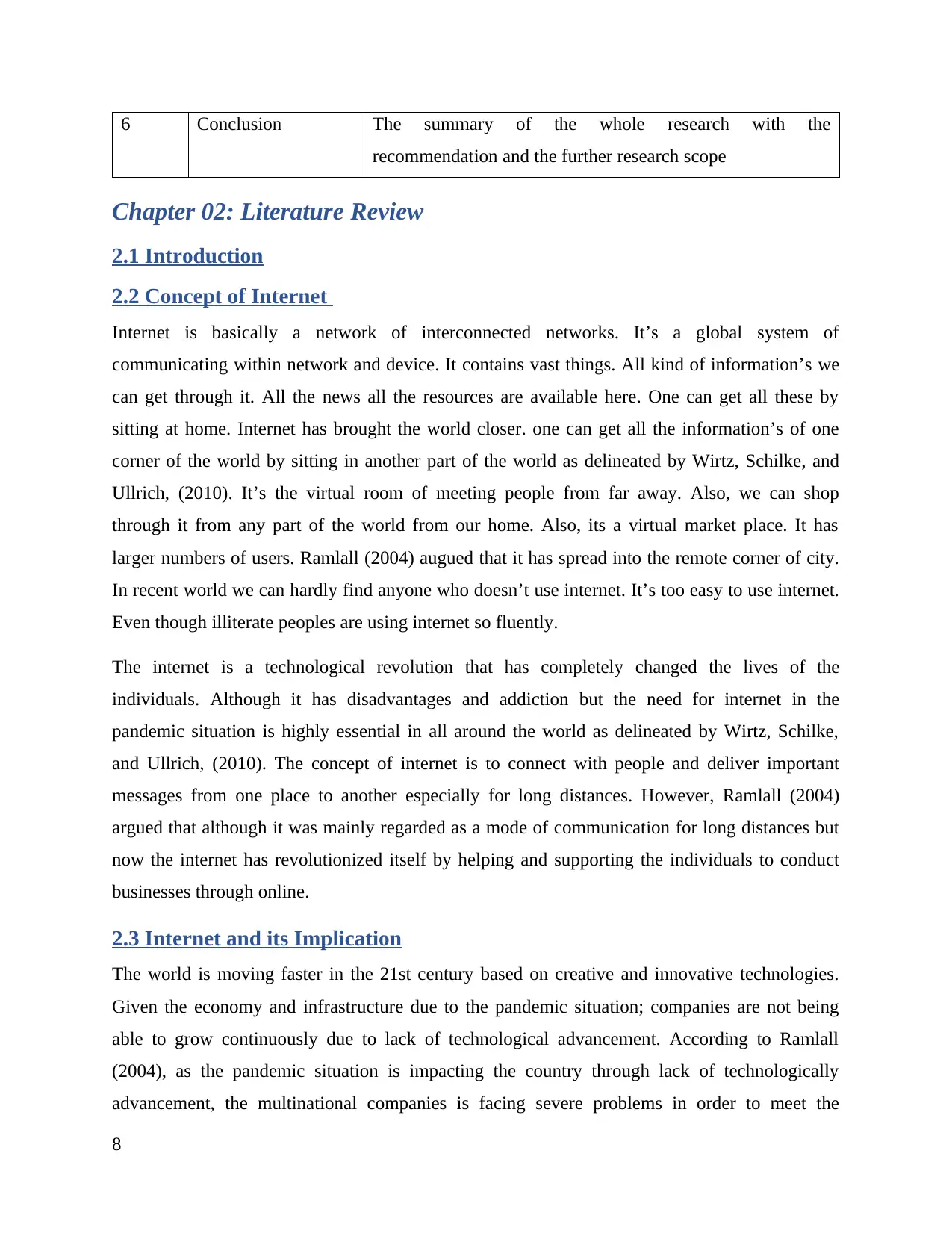
6 Conclusion The summary of the whole research with the
recommendation and the further research scope
Chapter 02: Literature Review
2.1 Introduction
2.2 Concept of Internet
Internet is basically a network of interconnected networks. It’s a global system of
communicating within network and device. It contains vast things. All kind of information’s we
can get through it. All the news all the resources are available here. One can get all these by
sitting at home. Internet has brought the world closer. one can get all the information’s of one
corner of the world by sitting in another part of the world as delineated by Wirtz, Schilke, and
Ullrich, (2010). It’s the virtual room of meeting people from far away. Also, we can shop
through it from any part of the world from our home. Also, its a virtual market place. It has
larger numbers of users. Ramlall (2004) augued that it has spread into the remote corner of city.
In recent world we can hardly find anyone who doesn’t use internet. It’s too easy to use internet.
Even though illiterate peoples are using internet so fluently.
The internet is a technological revolution that has completely changed the lives of the
individuals. Although it has disadvantages and addiction but the need for internet in the
pandemic situation is highly essential in all around the world as delineated by Wirtz, Schilke,
and Ullrich, (2010). The concept of internet is to connect with people and deliver important
messages from one place to another especially for long distances. However, Ramlall (2004)
argued that although it was mainly regarded as a mode of communication for long distances but
now the internet has revolutionized itself by helping and supporting the individuals to conduct
businesses through online.
2.3 Internet and its Implication
The world is moving faster in the 21st century based on creative and innovative technologies.
Given the economy and infrastructure due to the pandemic situation; companies are not being
able to grow continuously due to lack of technological advancement. According to Ramlall
(2004), as the pandemic situation is impacting the country through lack of technologically
advancement, the multinational companies is facing severe problems in order to meet the
8
recommendation and the further research scope
Chapter 02: Literature Review
2.1 Introduction
2.2 Concept of Internet
Internet is basically a network of interconnected networks. It’s a global system of
communicating within network and device. It contains vast things. All kind of information’s we
can get through it. All the news all the resources are available here. One can get all these by
sitting at home. Internet has brought the world closer. one can get all the information’s of one
corner of the world by sitting in another part of the world as delineated by Wirtz, Schilke, and
Ullrich, (2010). It’s the virtual room of meeting people from far away. Also, we can shop
through it from any part of the world from our home. Also, its a virtual market place. It has
larger numbers of users. Ramlall (2004) augued that it has spread into the remote corner of city.
In recent world we can hardly find anyone who doesn’t use internet. It’s too easy to use internet.
Even though illiterate peoples are using internet so fluently.
The internet is a technological revolution that has completely changed the lives of the
individuals. Although it has disadvantages and addiction but the need for internet in the
pandemic situation is highly essential in all around the world as delineated by Wirtz, Schilke,
and Ullrich, (2010). The concept of internet is to connect with people and deliver important
messages from one place to another especially for long distances. However, Ramlall (2004)
argued that although it was mainly regarded as a mode of communication for long distances but
now the internet has revolutionized itself by helping and supporting the individuals to conduct
businesses through online.
2.3 Internet and its Implication
The world is moving faster in the 21st century based on creative and innovative technologies.
Given the economy and infrastructure due to the pandemic situation; companies are not being
able to grow continuously due to lack of technological advancement. According to Ramlall
(2004), as the pandemic situation is impacting the country through lack of technologically
advancement, the multinational companies is facing severe problems in order to meet the
8
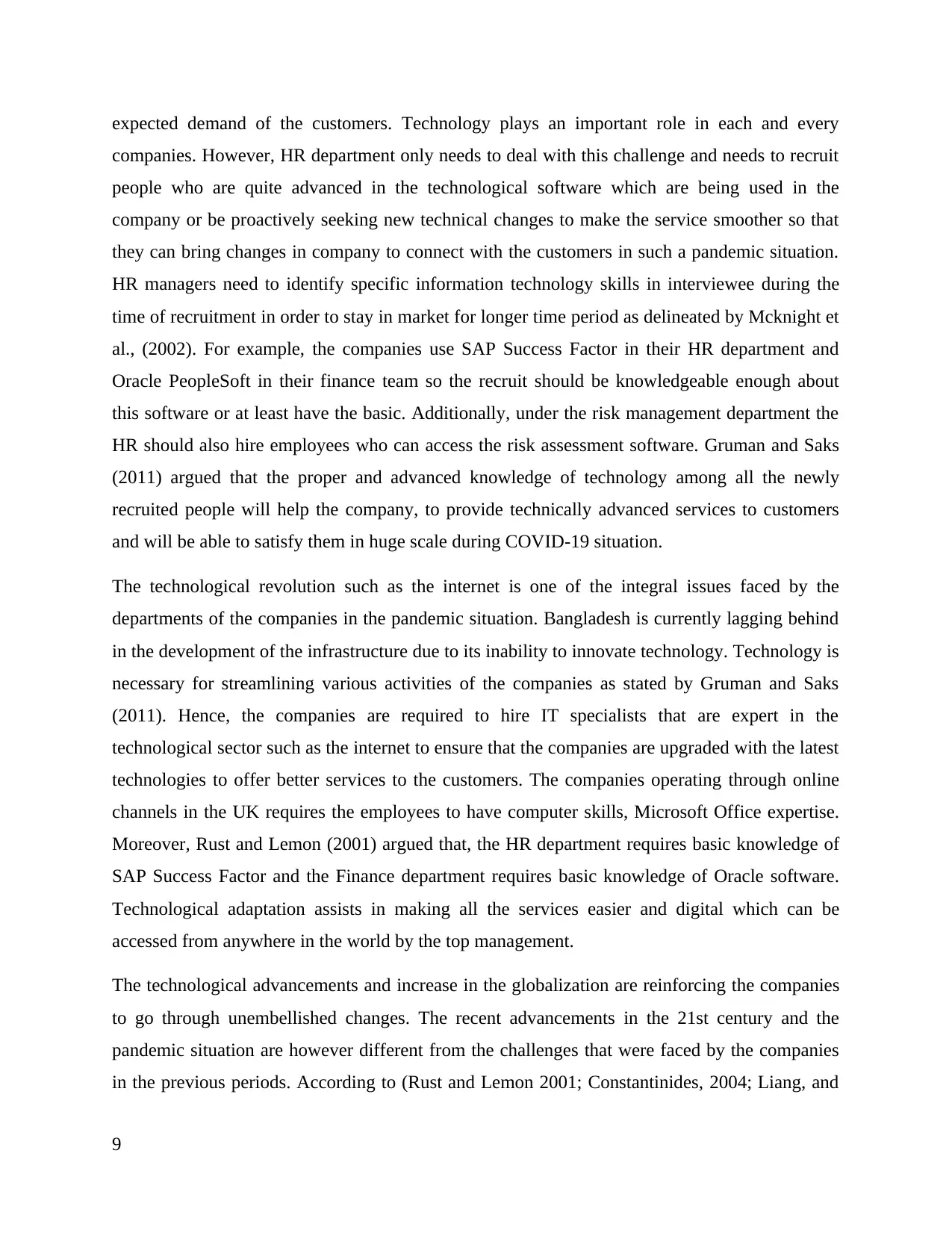
expected demand of the customers. Technology plays an important role in each and every
companies. However, HR department only needs to deal with this challenge and needs to recruit
people who are quite advanced in the technological software which are being used in the
company or be proactively seeking new technical changes to make the service smoother so that
they can bring changes in company to connect with the customers in such a pandemic situation.
HR managers need to identify specific information technology skills in interviewee during the
time of recruitment in order to stay in market for longer time period as delineated by Mcknight et
al., (2002). For example, the companies use SAP Success Factor in their HR department and
Oracle PeopleSoft in their finance team so the recruit should be knowledgeable enough about
this software or at least have the basic. Additionally, under the risk management department the
HR should also hire employees who can access the risk assessment software. Gruman and Saks
(2011) argued that the proper and advanced knowledge of technology among all the newly
recruited people will help the company, to provide technically advanced services to customers
and will be able to satisfy them in huge scale during COVID-19 situation.
The technological revolution such as the internet is one of the integral issues faced by the
departments of the companies in the pandemic situation. Bangladesh is currently lagging behind
in the development of the infrastructure due to its inability to innovate technology. Technology is
necessary for streamlining various activities of the companies as stated by Gruman and Saks
(2011). Hence, the companies are required to hire IT specialists that are expert in the
technological sector such as the internet to ensure that the companies are upgraded with the latest
technologies to offer better services to the customers. The companies operating through online
channels in the UK requires the employees to have computer skills, Microsoft Office expertise.
Moreover, Rust and Lemon (2001) argued that, the HR department requires basic knowledge of
SAP Success Factor and the Finance department requires basic knowledge of Oracle software.
Technological adaptation assists in making all the services easier and digital which can be
accessed from anywhere in the world by the top management.
The technological advancements and increase in the globalization are reinforcing the companies
to go through unembellished changes. The recent advancements in the 21st century and the
pandemic situation are however different from the challenges that were faced by the companies
in the previous periods. According to (Rust and Lemon 2001; Constantinides, 2004; Liang, and
9
companies. However, HR department only needs to deal with this challenge and needs to recruit
people who are quite advanced in the technological software which are being used in the
company or be proactively seeking new technical changes to make the service smoother so that
they can bring changes in company to connect with the customers in such a pandemic situation.
HR managers need to identify specific information technology skills in interviewee during the
time of recruitment in order to stay in market for longer time period as delineated by Mcknight et
al., (2002). For example, the companies use SAP Success Factor in their HR department and
Oracle PeopleSoft in their finance team so the recruit should be knowledgeable enough about
this software or at least have the basic. Additionally, under the risk management department the
HR should also hire employees who can access the risk assessment software. Gruman and Saks
(2011) argued that the proper and advanced knowledge of technology among all the newly
recruited people will help the company, to provide technically advanced services to customers
and will be able to satisfy them in huge scale during COVID-19 situation.
The technological revolution such as the internet is one of the integral issues faced by the
departments of the companies in the pandemic situation. Bangladesh is currently lagging behind
in the development of the infrastructure due to its inability to innovate technology. Technology is
necessary for streamlining various activities of the companies as stated by Gruman and Saks
(2011). Hence, the companies are required to hire IT specialists that are expert in the
technological sector such as the internet to ensure that the companies are upgraded with the latest
technologies to offer better services to the customers. The companies operating through online
channels in the UK requires the employees to have computer skills, Microsoft Office expertise.
Moreover, Rust and Lemon (2001) argued that, the HR department requires basic knowledge of
SAP Success Factor and the Finance department requires basic knowledge of Oracle software.
Technological adaptation assists in making all the services easier and digital which can be
accessed from anywhere in the world by the top management.
The technological advancements and increase in the globalization are reinforcing the companies
to go through unembellished changes. The recent advancements in the 21st century and the
pandemic situation are however different from the challenges that were faced by the companies
in the previous periods. According to (Rust and Lemon 2001; Constantinides, 2004; Liang, and
9
⊘ This is a preview!⊘
Do you want full access?
Subscribe today to unlock all pages.

Trusted by 1+ million students worldwide
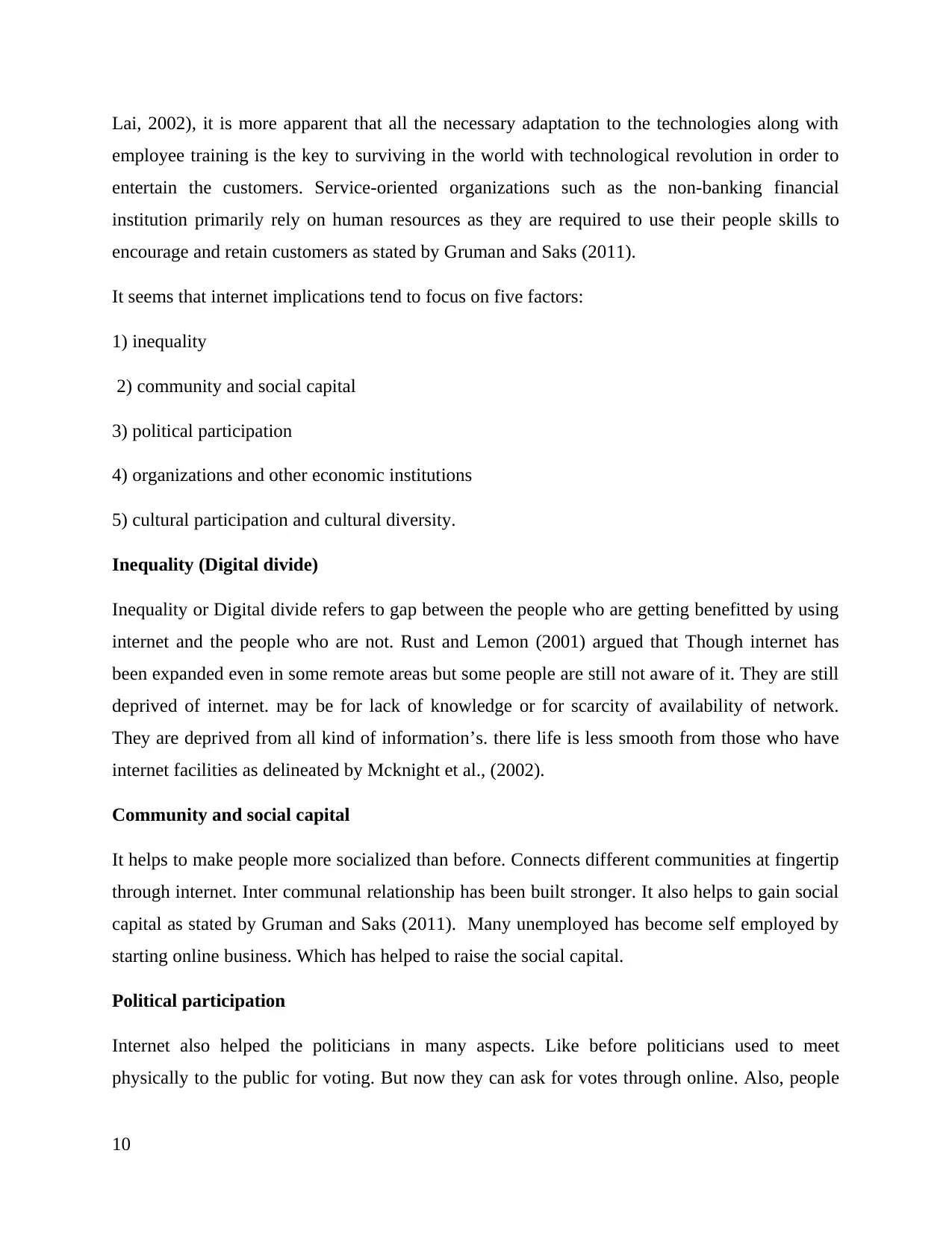
Lai, 2002), it is more apparent that all the necessary adaptation to the technologies along with
employee training is the key to surviving in the world with technological revolution in order to
entertain the customers. Service-oriented organizations such as the non-banking financial
institution primarily rely on human resources as they are required to use their people skills to
encourage and retain customers as stated by Gruman and Saks (2011).
It seems that internet implications tend to focus on five factors:
1) inequality
2) community and social capital
3) political participation
4) organizations and other economic institutions
5) cultural participation and cultural diversity.
Inequality (Digital divide)
Inequality or Digital divide refers to gap between the people who are getting benefitted by using
internet and the people who are not. Rust and Lemon (2001) argued that Though internet has
been expanded even in some remote areas but some people are still not aware of it. They are still
deprived of internet. may be for lack of knowledge or for scarcity of availability of network.
They are deprived from all kind of information’s. there life is less smooth from those who have
internet facilities as delineated by Mcknight et al., (2002).
Community and social capital
It helps to make people more socialized than before. Connects different communities at fingertip
through internet. Inter communal relationship has been built stronger. It also helps to gain social
capital as stated by Gruman and Saks (2011). Many unemployed has become self employed by
starting online business. Which has helped to raise the social capital.
Political participation
Internet also helped the politicians in many aspects. Like before politicians used to meet
physically to the public for voting. But now they can ask for votes through online. Also, people
10
employee training is the key to surviving in the world with technological revolution in order to
entertain the customers. Service-oriented organizations such as the non-banking financial
institution primarily rely on human resources as they are required to use their people skills to
encourage and retain customers as stated by Gruman and Saks (2011).
It seems that internet implications tend to focus on five factors:
1) inequality
2) community and social capital
3) political participation
4) organizations and other economic institutions
5) cultural participation and cultural diversity.
Inequality (Digital divide)
Inequality or Digital divide refers to gap between the people who are getting benefitted by using
internet and the people who are not. Rust and Lemon (2001) argued that Though internet has
been expanded even in some remote areas but some people are still not aware of it. They are still
deprived of internet. may be for lack of knowledge or for scarcity of availability of network.
They are deprived from all kind of information’s. there life is less smooth from those who have
internet facilities as delineated by Mcknight et al., (2002).
Community and social capital
It helps to make people more socialized than before. Connects different communities at fingertip
through internet. Inter communal relationship has been built stronger. It also helps to gain social
capital as stated by Gruman and Saks (2011). Many unemployed has become self employed by
starting online business. Which has helped to raise the social capital.
Political participation
Internet also helped the politicians in many aspects. Like before politicians used to meet
physically to the public for voting. But now they can ask for votes through online. Also, people
10
Paraphrase This Document
Need a fresh take? Get an instant paraphrase of this document with our AI Paraphraser
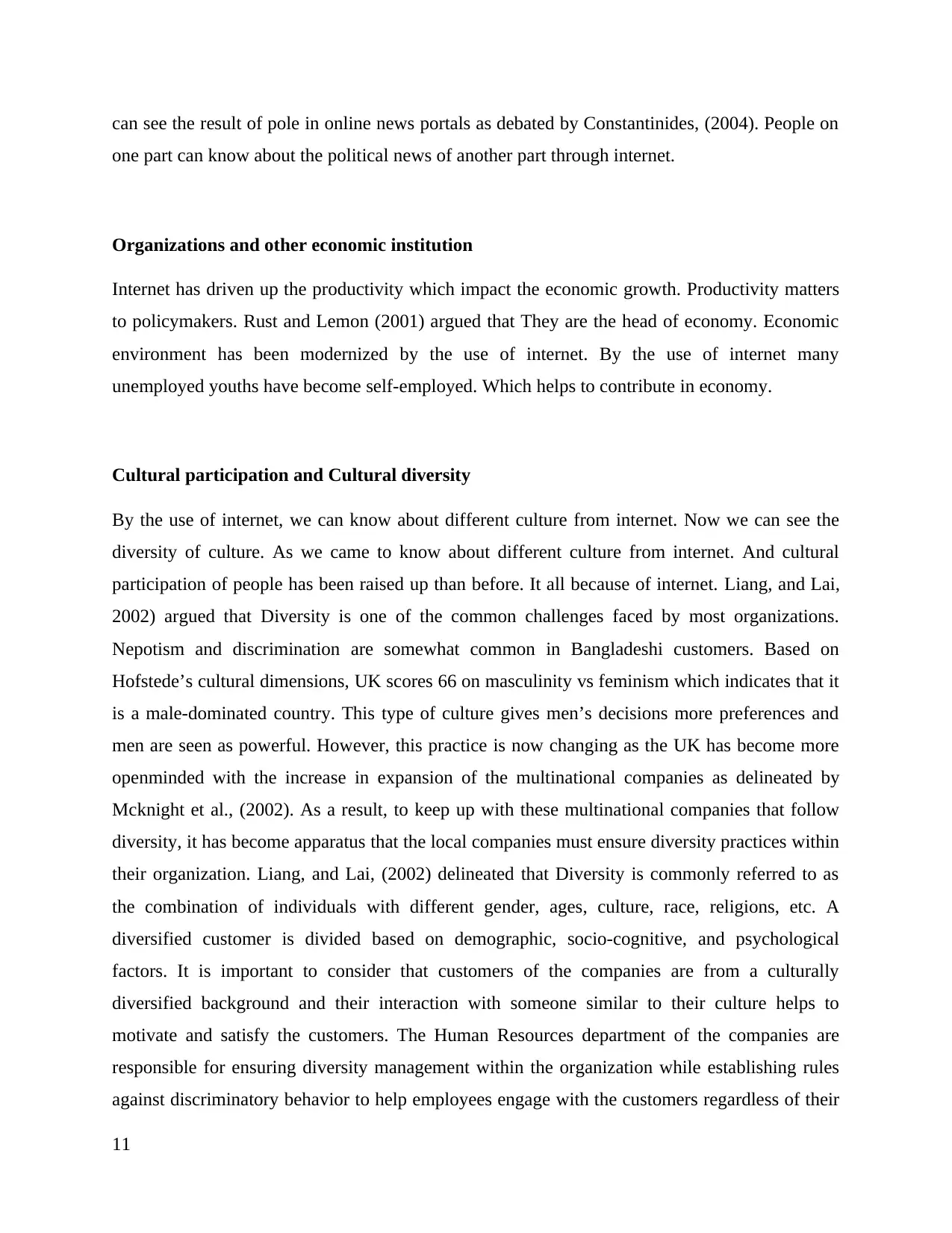
can see the result of pole in online news portals as debated by Constantinides, (2004). People on
one part can know about the political news of another part through internet.
Organizations and other economic institution
Internet has driven up the productivity which impact the economic growth. Productivity matters
to policymakers. Rust and Lemon (2001) argued that They are the head of economy. Economic
environment has been modernized by the use of internet. By the use of internet many
unemployed youths have become self-employed. Which helps to contribute in economy.
Cultural participation and Cultural diversity
By the use of internet, we can know about different culture from internet. Now we can see the
diversity of culture. As we came to know about different culture from internet. And cultural
participation of people has been raised up than before. It all because of internet. Liang, and Lai,
2002) argued that Diversity is one of the common challenges faced by most organizations.
Nepotism and discrimination are somewhat common in Bangladeshi customers. Based on
Hofstede’s cultural dimensions, UK scores 66 on masculinity vs feminism which indicates that it
is a male-dominated country. This type of culture gives men’s decisions more preferences and
men are seen as powerful. However, this practice is now changing as the UK has become more
openminded with the increase in expansion of the multinational companies as delineated by
Mcknight et al., (2002). As a result, to keep up with these multinational companies that follow
diversity, it has become apparatus that the local companies must ensure diversity practices within
their organization. Liang, and Lai, (2002) delineated that Diversity is commonly referred to as
the combination of individuals with different gender, ages, culture, race, religions, etc. A
diversified customer is divided based on demographic, socio-cognitive, and psychological
factors. It is important to consider that customers of the companies are from a culturally
diversified background and their interaction with someone similar to their culture helps to
motivate and satisfy the customers. The Human Resources department of the companies are
responsible for ensuring diversity management within the organization while establishing rules
against discriminatory behavior to help employees engage with the customers regardless of their
11
one part can know about the political news of another part through internet.
Organizations and other economic institution
Internet has driven up the productivity which impact the economic growth. Productivity matters
to policymakers. Rust and Lemon (2001) argued that They are the head of economy. Economic
environment has been modernized by the use of internet. By the use of internet many
unemployed youths have become self-employed. Which helps to contribute in economy.
Cultural participation and Cultural diversity
By the use of internet, we can know about different culture from internet. Now we can see the
diversity of culture. As we came to know about different culture from internet. And cultural
participation of people has been raised up than before. It all because of internet. Liang, and Lai,
2002) argued that Diversity is one of the common challenges faced by most organizations.
Nepotism and discrimination are somewhat common in Bangladeshi customers. Based on
Hofstede’s cultural dimensions, UK scores 66 on masculinity vs feminism which indicates that it
is a male-dominated country. This type of culture gives men’s decisions more preferences and
men are seen as powerful. However, this practice is now changing as the UK has become more
openminded with the increase in expansion of the multinational companies as delineated by
Mcknight et al., (2002). As a result, to keep up with these multinational companies that follow
diversity, it has become apparatus that the local companies must ensure diversity practices within
their organization. Liang, and Lai, (2002) delineated that Diversity is commonly referred to as
the combination of individuals with different gender, ages, culture, race, religions, etc. A
diversified customer is divided based on demographic, socio-cognitive, and psychological
factors. It is important to consider that customers of the companies are from a culturally
diversified background and their interaction with someone similar to their culture helps to
motivate and satisfy the customers. The Human Resources department of the companies are
responsible for ensuring diversity management within the organization while establishing rules
against discriminatory behavior to help employees engage with the customers regardless of their
11

differences as delineated by Patrick and Kumar (2012). Different cultures of customers allow the
company to grow. The promotion of diversity increases the fair treatment of all the customers
during the trading process. As a result, with the help of the internet the companies have the
advantage of creating value among the customers with the help of diversity management as it
increases cohesiveness among the employees while improving their performance and
productivity as indicated by Ramlall (2004).
2.3.1 Information accessibility
One can get all kind of information in internet. one can get all the information by one click
through internet. There are different search engines on the web like google, yahoo, Bing,
ask.com etc. by the use of such engines we can get all kind of information accessibility.
information’s are needed in every field. For research purpose, educational purpose, teaching
purpose etc. we need a lot of information’s. and all these kinds of information’s are available at
internet according to Liang, and Lai, 2002).
During covid 19 pandemic online portals used to provide information’s about this virus and
precautions about how to keep yourself safe from it.
One can know about what is available on foreign market and shop it from home. Though internet
we can shop from home as stated by Ramlall (2004). There is available size and measures all the
information about any product and dress is provided here. Also daily needed things are available
here. Also, medical services are available here. One can have primary medicate service at home
through online.
Scientists are increasing the use of internet for the purpose of gathering information’s. as they
need all the authentic and real data and information. Liang, and Lai, (2002) supported that So,
internet is the safest way of getting authentic data. They gather all the real data and information
and then the do their research.
12
company to grow. The promotion of diversity increases the fair treatment of all the customers
during the trading process. As a result, with the help of the internet the companies have the
advantage of creating value among the customers with the help of diversity management as it
increases cohesiveness among the employees while improving their performance and
productivity as indicated by Ramlall (2004).
2.3.1 Information accessibility
One can get all kind of information in internet. one can get all the information by one click
through internet. There are different search engines on the web like google, yahoo, Bing,
ask.com etc. by the use of such engines we can get all kind of information accessibility.
information’s are needed in every field. For research purpose, educational purpose, teaching
purpose etc. we need a lot of information’s. and all these kinds of information’s are available at
internet according to Liang, and Lai, 2002).
During covid 19 pandemic online portals used to provide information’s about this virus and
precautions about how to keep yourself safe from it.
One can know about what is available on foreign market and shop it from home. Though internet
we can shop from home as stated by Ramlall (2004). There is available size and measures all the
information about any product and dress is provided here. Also daily needed things are available
here. Also, medical services are available here. One can have primary medicate service at home
through online.
Scientists are increasing the use of internet for the purpose of gathering information’s. as they
need all the authentic and real data and information. Liang, and Lai, (2002) supported that So,
internet is the safest way of getting authentic data. They gather all the real data and information
and then the do their research.
12
⊘ This is a preview!⊘
Do you want full access?
Subscribe today to unlock all pages.

Trusted by 1+ million students worldwide
1 out of 50
Related Documents
Your All-in-One AI-Powered Toolkit for Academic Success.
+13062052269
info@desklib.com
Available 24*7 on WhatsApp / Email
![[object Object]](/_next/static/media/star-bottom.7253800d.svg)
Unlock your academic potential
Copyright © 2020–2025 A2Z Services. All Rights Reserved. Developed and managed by ZUCOL.


